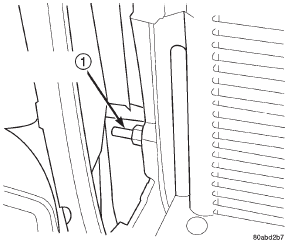Jeep Cherokee (XJ): Service procedures
NOTE: Do not remove radiator cap for routine
coolant level inspections. The coolant level can be
checked at coolant reserve/overflow tank.
The coolant reserve/overflow system provides a
quick visual method for determining coolant level
without removing radiator pressure cap. With engine
cold and not running, observe coolant level in
reserve/overflow tank. The coolant level should be
between ADD and FULL marks. Do not remove radiator cap to add coolant to
system. When adding coolant to maintain correct
level, do so at coolant reserve/overflow tank. Use a
50/50 mixture of ethylene-glycol antifreeze containing
Alugard 340-2 y and low mineral content water.
Remove radiator cap only for testing or when refilling
system after service. Removing cap unnecessarily
can cause loss of coolant and allow air to enter system,
which produces corrosion. The cooling system is closed and designed to maintain
coolant level to top of radiator.
WARNING: DO NOT OPEN RADIATOR DRAINCOCK
WITH ENGINE RUNNING OR WHILE ENGINE IS HOT
AND COOLING SYSTEM IS UNDER PRESSURE.
When vehicle servicing requires a coolant level
check in radiator, drain several ounces of coolant
from radiator drain cock. Do this while observing
coolant reserve/overflow system tank. The coolant
level in reserve/overflow tank should drop slightly. If
not, inspect for a leak between radiator and coolant
reserve/overflow system connection. Remove radiator
cap. The coolant level should be to top of radiator. If
not and if coolant level in reserve/overflow tank is at
ADD mark, check for: DRAINING WARNING: DO NOT REMOVE THE CYLINDER
BLOCK DRAIN PLUGS OR LOOSEN THE RADIATOR
DRAINCOCK WITH SYSTEM HOT AND UNDER
PRESSURE. SERIOUS BURNS FROM COOLANT
CAN OCCUR.
DO NOT WASTE reusable coolant. If the solution
is clean, drain the coolant into a clean container for
reuse.
(1) Remove radiator pressure cap. (2) For access to radiator draincock (Fig. 21),
remove radiator grille mounting screws and remove
grill. Refer to Group 23, Body for correct procedure.
1 - RADIATOR PETCOCK (3) Attach one end of a 24 inch long X 1/4 inch ID
hose to the radiator draincock. Put the other end into
a clean container. Open draincock and drain coolant
from radiator.
(4) Drain coolant from engine by removing the
drain plug and coolant temperature sensor on left
side of block. REFILLING (1) Tighten the radiator petcock and the cylinder
block drain plug(s).
(2) Install grille.
(3) Fill system using a 50/50 mixture of water and
antifreeze as described in the Coolant section of this
group. Fill radiator to top and install radiator cap.
Add sufficient coolant to reserve/overflow tank to
raise level to FULL mark.
(4) With heater control unit in the HEAT position,
operate engine with radiator cap in place.
(5) After engine has reached normal operating
temperature, shut engine off and allow it to cool.
(6) Add coolant to reserve/overflow tank as necessary.
Only add coolant when the engine is cold.
Coolant level in a warm engine will be higher
due to thermal expansion. CAUTION: The cooling system normally operates at
97-to-124 kPa (14- to-18 psi) pressure. Exceeding
this pressure may damage the radiator or hoses.
Reverse flushing of the cooling system is the forcing
of water through the cooling system. This is done
using air pressure in the opposite direction of normal
coolant flow. It is usually only necessary with very
dirty systems with evidence of partial plugging. CHEMICAL CLEANING If visual inspection indicates the formation of
sludge or scaly deposits, use a radiator cleaner
(Mopar Radiator Kleen or equivalent) before flushing.
This will soften scale and other deposits and aid the
flushing operation. CAUTION: Be sure instructions on the container
are followed. REVERSE FLUSHING RADIATOR
Disconnect the radiator hoses from the radiator fittings.
Attach a section of radiator hose to the radiator
bottom outlet fitting and insert the flushing gun.
Connect a water supply hose and air supply hose to
the flushing gun. CAUTION: The cooling system normally operates at
97-to-124 kPa (14- to-18 psi) pressure. Exceeding
this pressure may damage the radiator or hoses.
Allow the radiator to fill with water. When radiator
is filled, apply air in short blasts allowing radiator to
refill between blasts. Continue this reverse flushing
until clean water flows out through rear of radiator
cooling tube passages. For more information, refer to
operating instructions supplied with flushing equipment.
Have radiator cleaned more extensively by a
radiator repair shop. REVERSE FLUSHING ENGINE Drain the cooling system. Remove the thermostat
housing and thermostat. Install the thermostat housing.
Disconnect the radiator upper hose from the
radiator and attach the flushing gun to the hose. Disconnect
the radiator lower hose from the water
pump. Attach a lead away hose to the water pump
inlet fitting. CAUTION: Be sure that the heater control valve is
closed (heat off). This is done to prevent coolant
flow with scale and other deposits from entering
the heater core.
Connect the water supply hose and air supply hose
to the flushing gun. Allow the engine to fill with
water. When the engine is filled, apply air in short
blasts, allowing the system to fill between air blasts.
Continue until clean water flows through the lead
away hose. For more information, refer to operating
instructions supplied with flushing equipment Remove the lead away hose, flushing gun, water
supply hose and air supply hose. Remove the thermostat
housing and install thermostat. Install the thermostat
housing with a replacement gasket. Refer to
Thermostat Replacement. Connect the radiator
hoses. Refill the cooling system with the correct antifreeze/
water mixture.Coolant-routine level check
Coolant-adding additional
Coolant-level check
Cooling system-draining and
filling

Fig. 21 Radiator Petcock-2.5L/4.0L (LHD/RHD)Cooling system-reverse flushing
 Coolant-low level aeration. Deaeration
Coolant-low level aeration. Deaeration
Other materials:
Rear door latch striker. Rear door inside handle actuator. Rear door inner belt weatherstrip
Rear door latch striker
REMOVAL
(1) Using a grease pencil or equivalent, mark position
of striker.
(2) Remove screws attaching striker to C-pillar
(Fig. 52).
(3) Separate striker from C-pillar.
INSTALLATION
(1) Position and align striker on C-pillar.
(2) Install screws attaching strike ...

